.jpg)
It's easy to forget to stretch yourself. This is often overlooked because the results are not as visible as when you lift weights. Yet, stretching can lead to better posture, with less pain, and greater confidence. They release dopamine which helps you feel happier and more positive!
Vicky Timón, a yoga expert and author of "Encyclopedia of Pilates Exercises," created these beautiful illustrations and James Kilgallon, CSCS, creator of Mazlo's body maintenance program, contributed to the comments.
.jpg)
- Posture of the camel
The posture of the Camel and the Bow on their knees, are camber and postures of stretching, reputed to lead to complete deconditioning of the mind.
In this completely unusual position, some tension or a feeling of discomfort may appear, and breath control can sometimes be extremely difficult to achieve. But just be careful and tame the posture quietly, step by step. the position of the camel serves as a preparation for the posture of the bow on its knees.
2.GREEN FACIAL GAP
Muscles required: Adductors. This is an excellent exercise to open the hips and stretch the adductors and hamstrings. Throw this stretch with your knees bent and your back straight. When your muscles start to relax you can slowly straighten your legs, complete your back and reach your feet. Pull lightly on the toes of the feet to release the calf muscles. If you can not reach your feet, you can use a belt or a towel.
.jpg)
- The posture of the frog
The posture of the frog is suitable for improving the flexibility of the legs (especially the thigh muscles). The posture of the frog helps reduce excess fat in the body particularly in the thighs, hips and abdominal area. This yoga posture helps to tone the thigh muscles and increases the flexibility of the legs. It helps to relieve pain in the knees, ankles, back and to have a better functioning of the digestive system.
- Muscles worked: Adductors.
Start with both feet forward in a wide position with your legs as straight as possible. Keep your right foot flat on the floor.
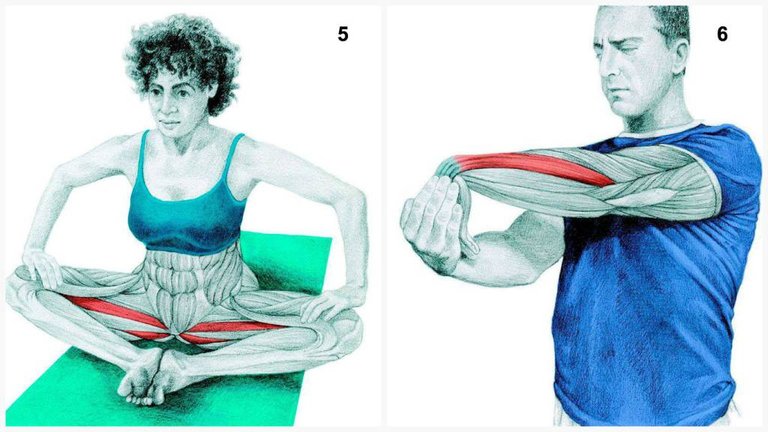
- BUTTERFLY STRETCH
Muscles worked: Adductors.
- EXTENSION OF FRONT ARMS
Muscles involved: the forearm. Once in this position apply pressure on your opposite hand to begin stretching.
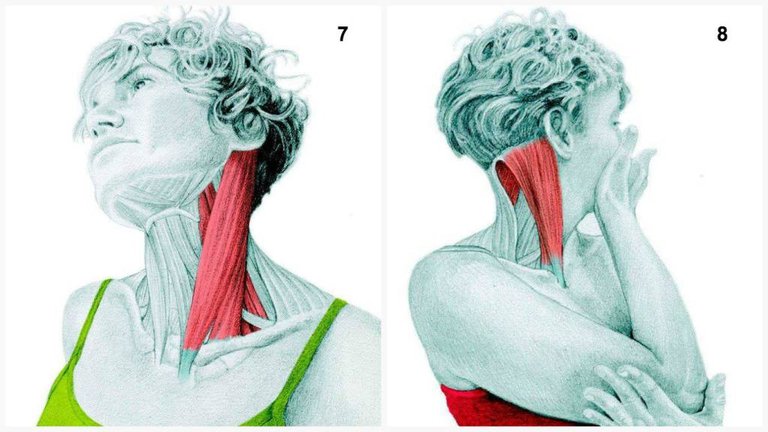
- LATERAL NECK FLEXION
Muscles worked: sterno-cleido-mastoid "SMC". Try to keep your neck as long as possible while slowly dropping your ear to your shoulder. Pay attention and avoid a vertebral compaction taking place when you do this You can progress by step while sitting on a chair. This will help you create cohesive tensions in the arm and neck.
- EXTENSIBLE NECK ROTATION
Muscles Worked: sterno-cleido-mastoid »SMC». Start with a slow rotation of your neck, while keeping your chin slightly higher to isolate the SMC. Be careful and avoid vertebral compression when you do this. If you want to get a deeper stretch apply pressure with the opposite hand to the direction you are rotating.
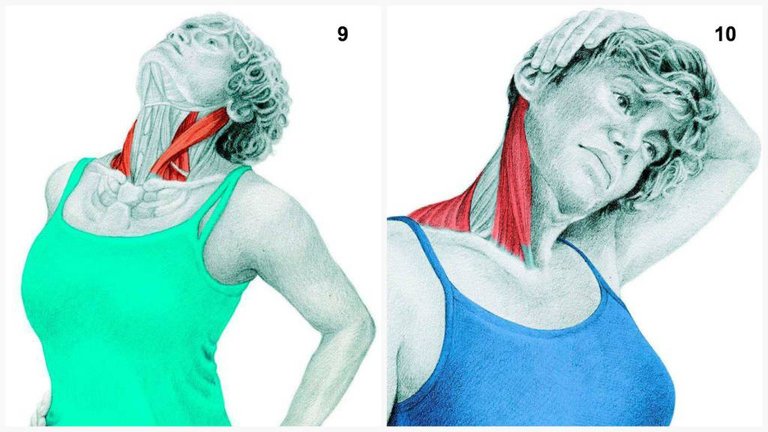
- BACK EXTENSION
Muscles worked: sterno-cleido-mastoid "SMC". Be careful and avoid vertebral compression when you do this. Start by placing your hands on your hips, and tilt your head back.
- LATERAL FLEXION OF A SIDE WITH HAND AID
Muscles worked: Sternocleidomastoid "SCM" and trapezium. Try to keep your neck as long as possible while slowly dropping your ear to your shoulder, be careful not to lean on your spine when you do this. You can step by step while sitting on a chair. This will help you create cohesive tensions in the arm and neck.
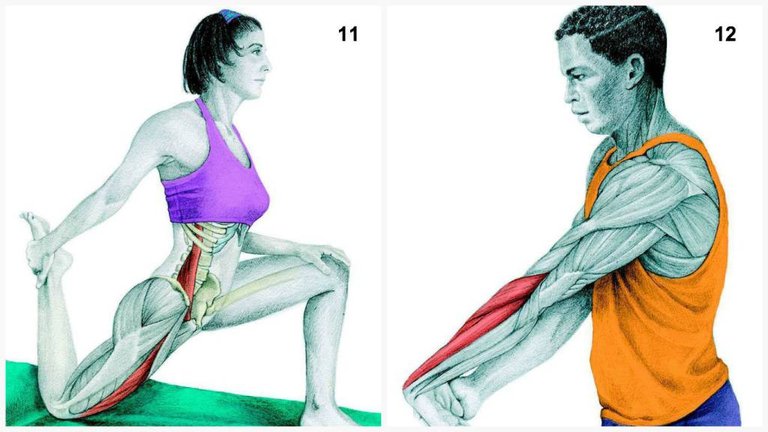
- HALF WITH HANDLE / HIP STRAP
Muscles worked: psoas and Quadracep. Start in semi-kneeling position. Take your foot back and squeeze your buttocks to increase the stretch on your hip flexor muscles.
- EXTENSION OF THE FRONT ARM
Muscles worked: Extensor muscles of the forearm. Once in this position apply pressure to your hand to begin stretching.
![Yoga13_14-1024x576.jpg]
(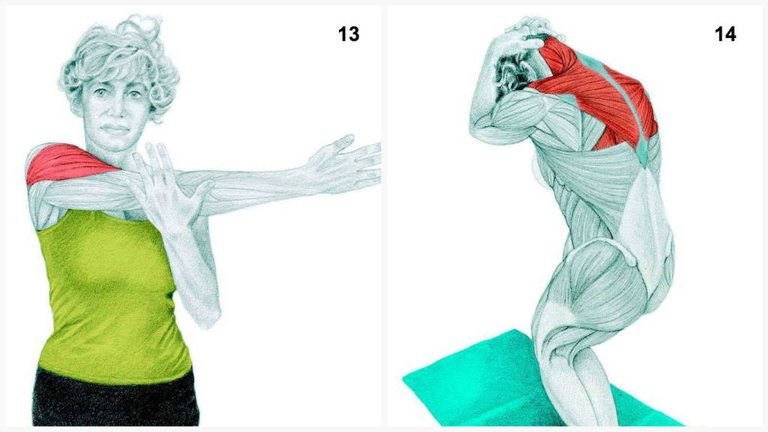 )
)
- SIDE SHOULDER EXTENSION
Muscles worked: deltoid. Apply a slight pressure on your arm to increase the stretch of your shoulder.
- NECK EXTENSION
Muscles worked: trapezium. Start standing with your feet together. Keep your spine straight, sit back slowly by tucking your chin towards your chest at the same time.
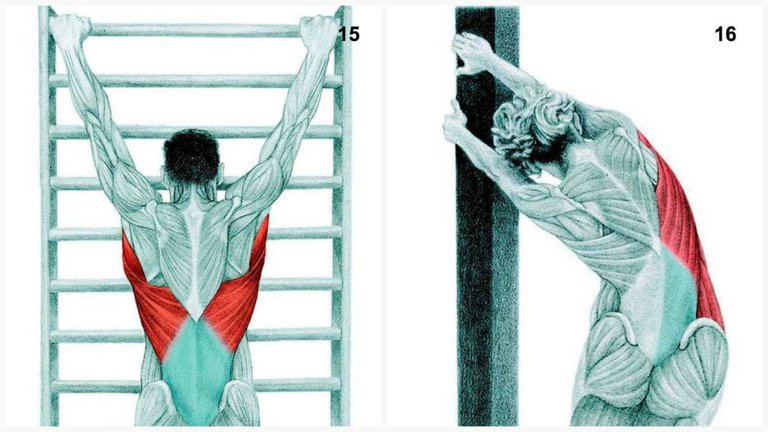
15.STRETCH WITH TRACTION BAR
Muscles worked: latissimus dorsi. Start by taking a firm grip on the bar, then slowly lift your feet off the ground. You should feel a stretch in your chest. If you lift your feet completely off the ground, you will feel the pull in your your column. Avoid this exercise if you have recently been injured in the shoulder.
- STRETCH AT THE WALL
Muscles worked: latissimus dorsi. Start by placing both hands on the corner of a wall or pole. While keeping your spine straight, slowly push your hips to the side. Avoid this exercise if you have low back problems.
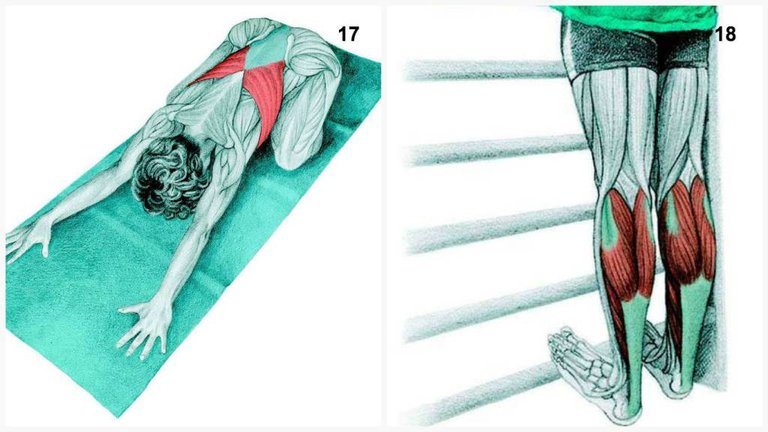 17. INSTALLATION OF THE CHILD
17. INSTALLATION OF THE CHILD
Muscles worked: latissimus dorsi. Start on your hands and knees, then slowly carry your hips back until your forehead touches the floor .. Camber your back and shoulders turned out to stretch the muscles of your chest.
- STRETCHING OF THE MOLLET
Solicited muscles: soleus and gastrocnemius. You can perform this exercise on a mat or on the edge of a step of stairs.
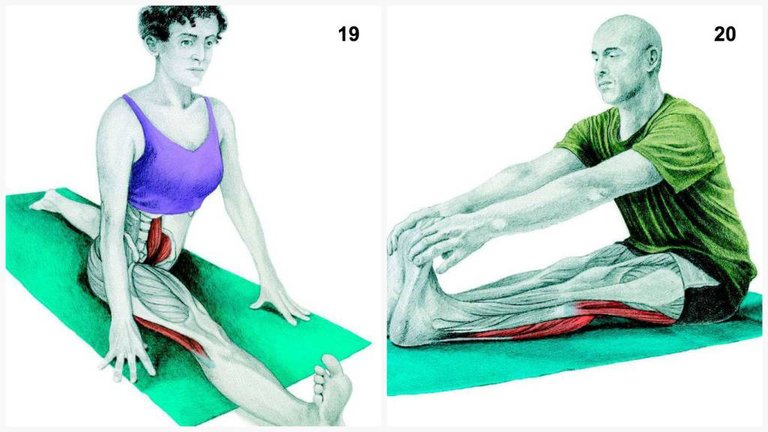
- GREAT GAP
Muscles worked: Psoas iliac and hamstrings. This is an exercise for the advanced, proceed with caution if you have hip problems.
- FRONT READY SEAT
Muscles required: hamstrings and calves. Start sitting and bend your knees if necessary. If you have back problems keep the spine as straight as possible. You can also perform this exercise lying on the back with your feet up a wall.
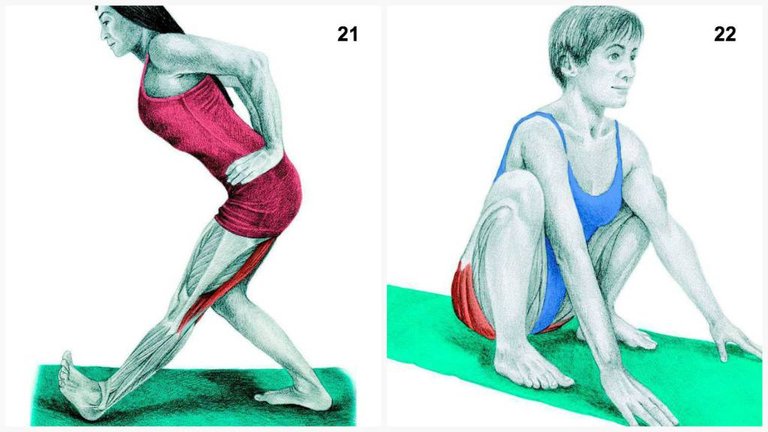
- FOLDING ON A LEG
Muscles worked: hamstrings. Take this position with one foot in front of the other. Put your hands on your hips and while keeping your back straight, and begin to bend from the hips.
- INCREASED
Muscles worked: glutes. This movement has an overall effect on all areas of your body. If you have knee problems, or you can not keep your heels on the floor, do your squat before you continue. Start standing, then slowly lower yourself until you are crouching. Once in position put your arms inside your legs and apply a slight pressure inside your knees, in the hips and heels. You can also take this lying position on your back with your feet against a wall.
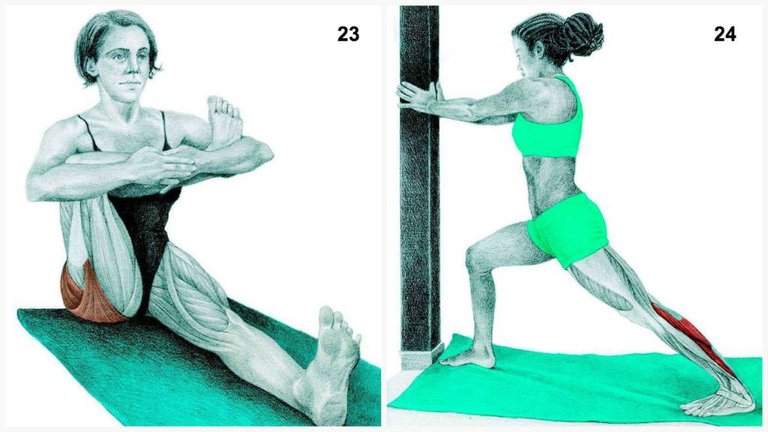
- SITTING IN HALF PIGEON
Muscles worked: glutes. Start in a sitting position, slowly pull your leg towards your chest and outwardly turn your hip while keeping your back straight. You should feel it in your buttocks.
- STRETCHING THE MOLLET TO THE WALL
Muscles worked: soleus and gastrocnemius. Start in a position with your back foot slightly raised. Then slowly lower your heel to the ground to stretch the calf muscles.
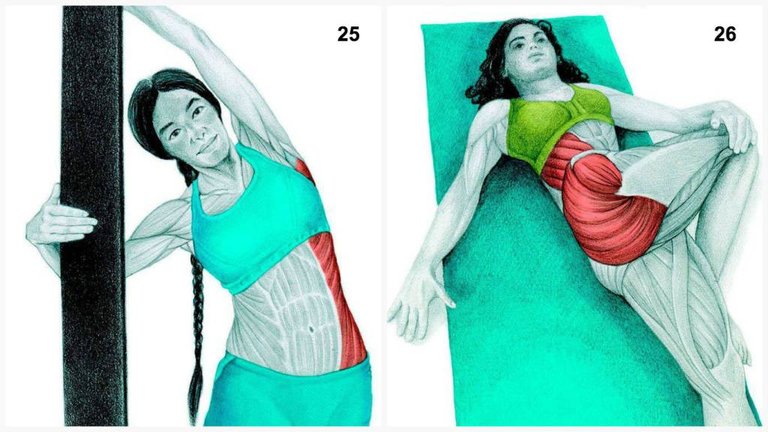
- LATERAL WALL FLEXION
Muscles worked: External obliques. While keeping your spine right, slowly push your hips to the side. Avoid this exercise if you have low back problems.
- ROTATION
Muscles involved: the buttocks and external obliques. This exercise is great for those trying to manage sciatic pain. Start by lying flat on your back and put a leg on your body, slowly turning your eyes and upper body in the opposite direction. The key to this exercise is to use your breath to open your rib cage and your sacro-iliac joint and hip area without putting too much pressure on the lower back. If you find this exercise too difficult, you can fold your two knees one above the other. Once in this position, you will feel a stretch of the upper spine when the knees are higher, and more on the spine and your lumbar when the knees are lower.
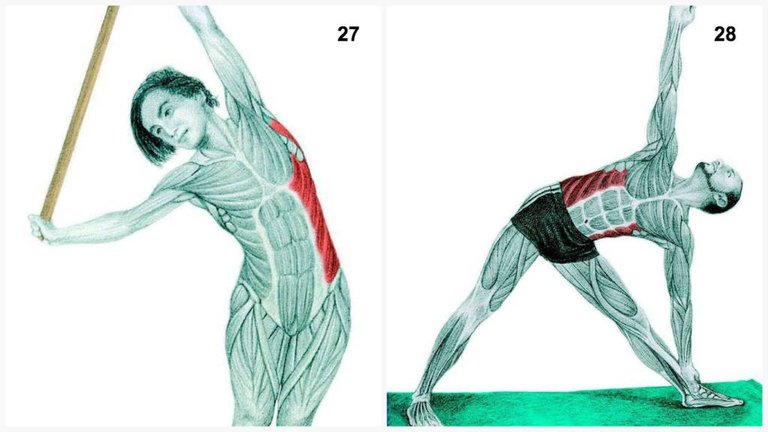
- LATERAL FLEXION WITH AN ANKLE
Muscles worked: external obliques and dorsal fin. With your right spine, slowly push your hips to the side while keeping your shoulders rotating externally. Avoid this exercise if you have low back problems.
- IN THE TRIANGLE
Muscles wobbled: External obliques. Start with a wide position of your right front foot, and your back foot to 90 degrees. Place your hand on your front leg. When you are away from your leg before keep your eyes on the hand that is in the air.
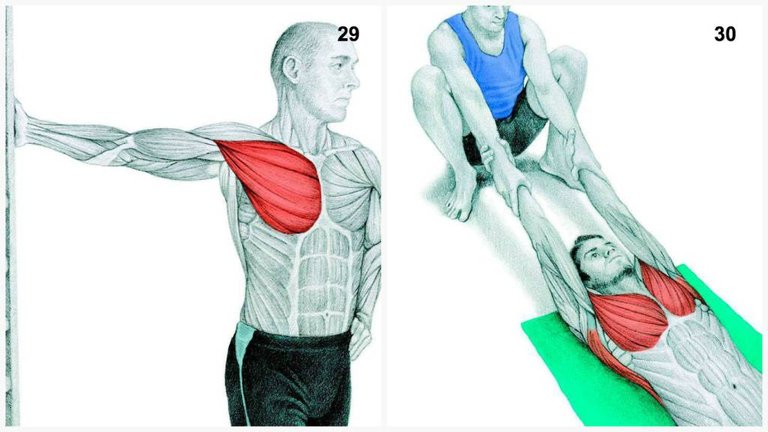
- STRETCHING THE CHEST TO THE WALL
Muscles worked: pectoral. Start facing the wall with your thumb. Slowly turn you away from the wall and stretch your chest muscle. You should feel this exercise in the belly muscles.
30.BREAKING OF CHEST
Muscles worked: Chest and latissimus dorsi. Avoid this exercise if you have shoulder problems.
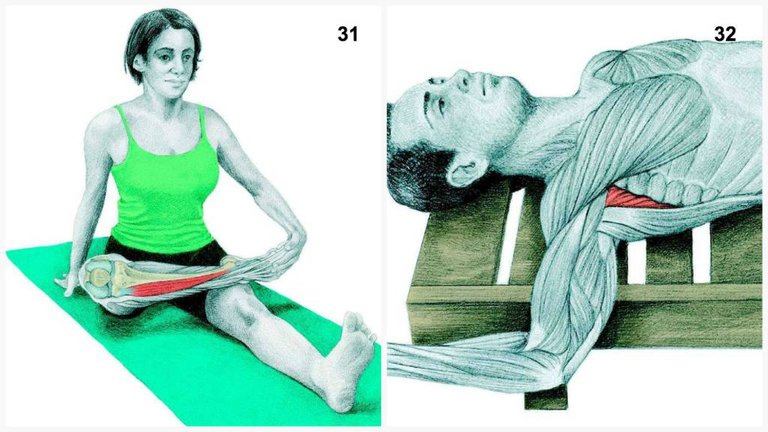
- SITTING IN HALF PIGEON YOGA
Muscles worked: Anterior tibial muscle To increase the stretch on your hip slowly lean forward.
- EXTERNAL ROTATION SHOULDER
Muscles involved: sub-scapular.
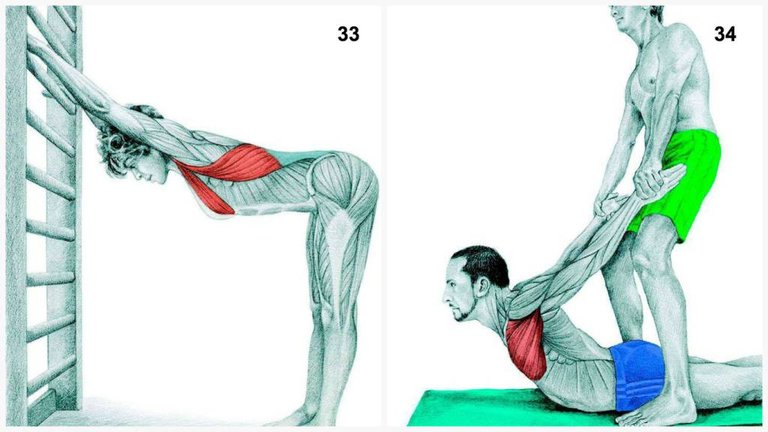
- WORKING WITH A WALL
Muscles Worked: pectoral and muscle of the latissimus dorsi. Place yourself far enough away from a wall, so that when you touch the wall your body becomes parallel to the ground. Once in position, push your chest forward it will give a slight camber to the upper back, and chest muscles.
- ASSISTED
Muscles worked: pectoral. Start by bed on the belly on the floor with your palms down. Your partner pulls on your hands, and you will feel a deeper stretch of your chest muscles. Avoid this exercise if you have shoulder problems.
This post recieved an upvote from minnowpond. If you would like to recieve upvotes from minnowpond on all your posts, simply FOLLOW @minnowpond
Congratulations @hichamoun! You have completed some achievement on Steemit and have been rewarded with new badge(s) :
Click on any badge to view your own Board of Honor on SteemitBoard.
For more information about SteemitBoard, click here
If you no longer want to receive notifications, reply to this comment with the word
STOPHi, as a sign of my support for the tag #sports and #football, I vote for you and begin to follow you
thanks, me too
Praise be to God and praise Praise be to God Almighty created in his creation and the body of man any of the signs of God in his creation @bakabou159704
صاحا خويا
صاحا خويا هل انت جزائري....????
الرياضة مهمةلجسم الإنسان وللاناقته
العقل السليم في الحسم السليم
مقاطع فيها تقريبا جميع النقط المهمة في جسم الانسان.
إلتفاتة جميلة احسنت الاختيار